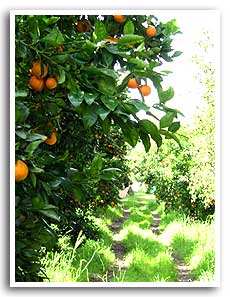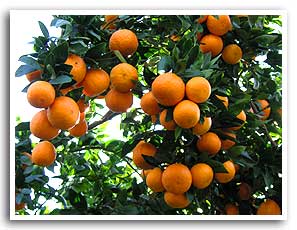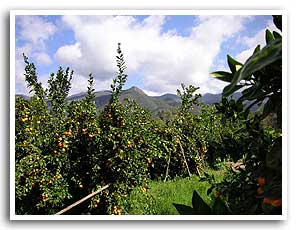
Photos by Lisa Brenneis
More pixie science than you may have wanted: The origin of the Pixie Tangerine is shrouded in a bit of mystery: scientific literature says that the Pixie Tangerine is “a second generation hybrid (or possibly a self) obtained from open pollination of an F1 hybrid called a Kincy, meaning that the “seed parent” was a tangerine variety called a Kincy (a cross between a Dancy and a King), but no one knows what the pollen parent was.
Citrus breeder Howard Frost obtained the parent seed in 1927. Actual development and testing of the fruit didn’t begin until many years later, at the University of California at Riverside. UCR breeders spent a couple of decades planting out trees to see how they would grow under different conditions and what their fruit was like. In 1965, UCR breeders James Cameron (the plant breeder, not the film director) and Robert Soost finally released the Pixie, which they recommended only as a “backyard tree.”
The Pixie’s commercial value was thought to be limited because it takes a long time to come into bearing – you don’t get any fruit worth harvesting until at least 4 years, and the tree doesn’t come into anything approaching full bearing until 8 years; it’s alternate bearing – meaning heavy crop years are followed by light crop years and vice versa; and (probably) because at the time of its release in 1965 “tangerine season” was considered to be around Christmas time, so the Pixie came ripe at a time when no one was expecting to buy or sell tangerines.
Why Ojai? Blissfully or deliberately ignorant of these citrus marketing conventions, two Ojai growers, Tony Thacher and Jim Churchill, planted commercial quantities of Pixie tangerines in the early 1980’s, intending to increase the varieties of fruit they had for direct sales. It turned out that Pixie Tangerines grown in Ojai are fabulous – sweet, seedless, and easy to peel. By the mid-1990’s, other local growers had decided to join the Ojai Valley Pixie Party and we all created the Ojai Pixie Growers’ Association to share information about cultural practices and to develop a market for our locally grown fruit.
The Pixie came to the Ojai Valley long before the 1980s. When Cameron and Soost were working on developing the Pixie variety, they contacted an Ojai grower named
Frank Noyes. This is standard procedure: because citrus in general and tangerines in particular are quite sensitive to different microclimates, plant breeders at the University cooperate with growers around the state to plant a variety which is being considered for commercial release in different areas, to determine if the variety is worth releasing. Frank Noyes found that the Pixies produced in his Ojai orchard were delicious.
Elmer Friend, whose family had been growing and marketing Dancy tangerines for more than a generation, was helping Frank pick and sell his Dancy, Page, Minneola, and Pixie crops. Friend’s Ranch customers certainly showed their enthusiasm for the Ojai Pixie as a late-season tangerine. Elmer had recently acquired the Sheldon Ranch in the frost-free area of Matilija Canyon from that family of homesteaders; and Friend’s Ranches planted some of their new ranch to Ojai Pixies as well as Dancys, Satsumas, and Algerians, an early seedy Clementine variety. Elmer built a small packinghouse and roadside stand to market his fruit wholesale and retail. Buying directly from Friend’s Ranches, the public continued to enjoy the Ojai Pixie as a spring-time tangerine.
Jim Churchill returned to Ojai in the late 70’s and, after sampling the Ojai Pixies at Friends Ranches, got busy replacing his family’s old avocado orchard. As his crop reached commercial proportions, the first focused effort to market Ojai Pixie Tangerines was born.
 Others became interested and have joined in growing Ojai Pixies. Mike Shore was packing Jim Churchill’s fruit, and having purchased a ranch in the east end of the Ojai Valley, also planted some Pixies.
Others became interested and have joined in growing Ojai Pixies. Mike Shore was packing Jim Churchill’s fruit, and having purchased a ranch in the east end of the Ojai Valley, also planted some Pixies.
Larry and Pat Hartmann tired of growing Christmas trees and put in Pixies in the early 90’s.
Tony Thacher, Elmer Friend’s son-in-law, partnered with Bob Davis and removed an old block of Navel oranges on the McNell Creek Ranch and replaced it with Ojai Pixies.
Different growers have had different reasons for planting Ojai Pixies; the result is that there are currently more than 20 different Ojai families who have now planted upwards of 25,000 Ojai Pixie trees. Most of these trees were planted in the late 90’s and will be coming into production in the new millennium.
You can visit some of their farms on-line. All are family-run operations, whether 50 or 5000 trees. All live in the Ojai Valley and grow their Ojai Pixies independently.
 The Ojai Pixie Growers Association was formed to share information about growing this finicky fruit and to coordinate the marketing of Ojai Pixie Tangerines.
The Ojai Pixie Growers Association was formed to share information about growing this finicky fruit and to coordinate the marketing of Ojai Pixie Tangerines.
The successes and failures of everything from pruning, fertilizing, harvesting, selling, and cooking with Ojai Pixies are shared among the members of the Ojai Pixie Growers Association at our meetings. We’ve used them at breakfast, cocktail hour, desserts and even in wedding bouquets. You too can participate, let us know your Ojai Pixie stories: Give us your feedback by email.


